1 KEYS TO READING COMPREHENSION Before During After

1 KEYS TO READING COMPREHENSION Before, During, After Reading, Listening, Viewing

2 Anita L. Archer, PHD Author, Consultant, and Teacher archerteach@aol. com www. explicitinstruction. org Archer, A. , & Hughes, C. (2011). Explicit Instruction: Effective and Efficient Teaching. NY: Guilford Publications.

3 BEFORE READING, LISTENING, VIEWING

4 Before Reading Strategies - Preview • Teach the pronunciation and meaning of critical, unknown vocabulary words. • Teach or activate any necessary background knowledge. • Guide students in previewing the article/chapter. • Establish a clear purpose for reading.

5 FRONTLOAD VOCABULARY

6 Frontload – Vocabulary BIG IDEA: If students can accurately pronounce and understand the meaning of critical vocabulary terms in the passage, their comprehension will be enhanced.

7 Explicit Instruction of Vocabulary - Why Vocabulary is related to reading comprehension. “Indeed, one of the most enduring findings in reading research is the extent to which students’ vocabulary knowledge relates to their reading comprehension. ” (Osborn & Hiebert, 2004)

8 Explicit Instruction of Vocabulary - Why • “direct vocabulary instruction has an impressive track record of improving students’ background knowledge and comprehension of academic content. ” Marzano, 2001, p. 69 • . 97 effect size for direct teaching of vocabulary related to content (Stahl & Fairbanks, 1986) • Hattie Effect Size for Vocabulary Programs 0. 67

9 Long Term Vocabulary Goal By the end of high school, college-ready students will need to acquire about 80, 000 words. (Hirsh, 2003)

10 Selection of Vocabulary - Summary v. Select a limited number of words. v. Select words that are unknown. v. Select words critical to passage or unit understanding. v. Select words that can be used in the future. v. Select words that have word relatives. v. Select words that contain “meaningful parts” (prefix, suffix, root). v. Select difficult words that need interpretation. Retrieval Practice

11 Vocabulary Instructional Routine Step 1: Introduce the word’s pronunciation. Step 2: Introduce the word’s meaning. Step 3: Illustrate the word with examples. (and non-examples when helpful) Step 4: Check students’ understanding.

12 Explicit Instruction of Vocabulary Step 1. Introduce the word’s pronunciation. a) b) Show the word on the screen. Read the word and have the students repeat the word. If the word is difficult to pronounce or unfamiliar have the students repeat the word a number of times or say the parts of the word as they tap. Introduce the word with me. This word is complication. What word? complication Tap and say the parts of the word. com pli ca tion Read the word by parts. (loop under the parts of the word) complication What word? complication Complication is a noun.

13 Explicit Instruction of Vocabulary Step 2: Introduce the word’s meaning. Tell students the explanation. OR Have them read the explanation with you. A complication is something that makes a situation harder to deal with or more difficult to do.

14 Step 3: Illustrate the word with examples. Construction of Panama Canal 1881 – 1914 complications • hot temperatures • jungle environment • mosquitos • disease • deaths • engineering challenges • and many MORE

15 Step 3: Illustrate the word with examples. Situation Complication You are preparing to study. You left your book at school. That is a. . . You are going to wash the family’s clothes. The washing machine is broken. That is a. . . You are going to a friend’s birthday party. You don’t know the friend’s address and you don’t have a present. Those are. . . You are fixing spaghetti for a There is no pasta in the family dinner. cupboard. That is a. . .

16 Step 4: Check students’ understanding. Everyday complications Situation Complication You are hoping to run a marathon. One complication is. . . You have to walk one mile One complication is. . . to school. You are babysitting two children, ages 3 and 5. One complication is. . . You are planning a trip to Florida in the winter. Some complications include. . .

17 Step 4: Check students’ understanding. Compare and contrast the words complication and difficulty. Ones, tell your partner how these words are the same. Twos, tell your partner how these words are different.

18 FRONTLOAD – BACKGROUND KNOWLEDGE

19 Frontload Background Knowledge Big Idea: If students have the background knowledge required by a passage, their comprehension will be enhanced.

20 Background Knowledge - Why • Background knowledge of text has a major impact on whether or not a reader can comprehend text. Anderson & Pearson, 1984; Bransford, Stein, & Shelton, 1984; Wilson & Anderson, 1986 • Across grades and reading ability, prior knowledge of subject area and key vocabulary results in higher scores on reading comprehension measures. Langer, 1984; Long, Winograd, & Bridget, 1989; Stevens, 1980

21 Background Knowledge – Why • Average correlation between person’s background knowledge of a given topic and extent to which a person learns new information is. 66. Marzano, 2004 • Prior knowledge has a large influence on student performance, explaining 30 to 60% of variance in performance. • • • Docy, Segers, & Buehl, 1999 Marr & Gormley, 1982 Gaultney, 1995 Kahmi, 2009. 2012

22 Background Knowledge - Why The more students know, the broader range of texts they can comprehend. Willingham, 2015

23 Background Knowledge - Selection Introduce facts and knowledge that are: a. Critical b. Useful for immediate comprehension c. Useful in the future d. Meaningfully connected to other knowledge

24 Frontload Background Knowledge - Why BIG IDEA Even a thin slice of background knowledge is useful.

25 A HIGHWAY OF WATER Panama Canal

26 Location of the Country of Panama

27 Canal A canal is a human-made waterway that provides passage between two natural bodies of water

28 Panama Canal The Panama Canal is a human-made waterway that provides passage between two natural bodies of water, the Atlantic Ocean and the Pacific Ocean.

29 Map – Panama Canal

30 Gatun Lake is an artificial lake that forms a major part of the Panama Canal. Gatun Lake is 85 feet above sea level.

31 locks Lock • a device • used for raising and lowering boats and ships • between different water levels on river and canal waterways

32 locks

33 Ships traveling through Panama Canal

34 Ships traveling through Panama Canal

35 Ships traveling through Panama Canal

36 Important Trade Route Today

37 Fun Facts – Panama Canal Number of Vessels 1914 -1, 000 vessels 2014 -14, 000 vessels Time to Cross Panama Canal 8 to 10 hours Toll (Cost to use Panama Canal) Average toll = $150, 000

38 Fun Fact – Panama Canal The Panama Canal has been designated as one of the Seven Wonders of the Modern World.

39 PREVIEW THE TEXT

40 Preview the Text Big Idea: If students preview a passage, their comprehension will be enhanced.

41 Preview the Informative Text - Why As the student previews, he/she discovers: • the topics to be covered, • the information that will be emphasized, • how the material is organized. • In addition, background knowledge is activated.

42 Preview Informative Text - How • Guide students in previewing the chapter and formulating a topical outline using the text structure: title, introduction, headings, subheadings, questions. • Has students preview the selection independently, with his/her partner, or team members.

43 Preview Informative Text Warm-Up Before you read a chapter or a section of a chapter in your science, social studies, or health book, Warm-up. Get an idea of the chapter’s content by previewing these parts. BEGINNING • Title • Introduction MIDDLE • Headings • Subheadings END • Summary • Questions Curriculum Associates, Skills for School Success

44 Preview: A Highway of Water - Panama Canal A Highway of Water The Solution The First Attempt to Build the Panama Canal The United States Decides to Finish the Canal Using the Panama Canal

45 ESTABLISH PURPOSE FOR READING

46 Establish Purpose Big Idea: When a purpose for reading directs students’ attention, comprehension is enhanced.

47 Learning Intentions Students will be able to: - Explain why the Panama Canal was built. - Summarize the sequence of attempts to build the Panama Canal from 1881 to 1914. - Describe the complications in constructing the Panama Canal. - Explain the importance of the Panama Canal today.

48 Success Criteria I will write three paragraphs about the Panama Canal using the following topic sentences: 1) The Panama Canal was built for the following reasons. 2) From 1881 to 1914, there were numerous attempts to build a canal connecting the Atlantic and Pacific Oceans in Central America. 3) Even though it is more than 100 years after the construction of the Panama Canal, it remains important today.

49 Before Reading Strategies - Review • Teach the pronunciation and meaning of critical, unknown vocabulary words. • Teach or activate any necessary background knowledge. • Guide students in previewing the article/chapter. • Establish a clear purpose for reading.

50 DURING READING, LISTENING, VIEWING

51 Purpose of During Reading Strategies • Focus on critical content • Increase attention and concentration • Rehearse critical content Executive function is required for comprehending oral and written language. Cain & Bigrell, 2014

52 During Reading - Preview • Read Stop Respond • Respond – Questions • Teacher generated text dependent questions • Student generated questions • Respond – Strategies - Informative • Verbally retell topic and key details • Generate main idea statements • Annotate the passage • Take two column notes on content • Map the content

53 READ STOP RESPOND Teacher-generated, text-dependent questions

54 During Passage Reading Ask Questions Asking questions. A evidence-based, time honored procedure The teacher asks questions to guide and monitor students’ comprehension. (Ambruster, Lehr, & Osborn, 2001; National Reading Panel, 2000; Mc. Keown, Beck, & Blake, 2009) )

55 Focus on Text-Dependent Questions Text dependent questions • Can only be answered with evidence from the text or content presented YOU HAVE TO READ THE TEXT!

56 Focus on Text-Dependent Questions Read these two questions. Circle the number of the textdependent question. 1. What were the major goals of the United Nations as outlined in the UN preamble? 2. If you had been on the UN committee with Eleanor Roosevelt, what goals would you have included in the UN preamble?

57 Text-Dependent Questions WHY • Keeps reader IN the text - NOT OUT of the text • Departing the text removes students’ cognition from the text message, reducing concentration and comprehension

58 Focus on Text-Dependent Questions

59 Text-Dependent Questions – Informative Text Highway of Water Paragraph #1 Before the Panama Canal was built, how did people travel from the East Coast to the West Coast of the United States? Begin by saying: Before the Panama Canal was built, people traveled from the East Coast to the West Coast of the United States using one of these three routes. One route was. . . Another route was. . . The third route was. . .

60 Text-Dependent Questions – Informative Text Highway of Water Paragraph #1 What were some of the complications resulting from taking these routes? Begin by saying: Some of the complications of these routes were. . .

61 Text-Dependent Questions – Informative Text Highway of Water Paragraph #2 Why did the authors describe a canal as a highway made of water? Begin by saying: The authors described a canal as a highway made of water because. . .

62 Text-Dependent Questions – Informative Text Highway of Water Paragraph #3 When planning for a canal from the Pacific Ocean to the Atlantic Ocean, what country was initially selected? Was this plan carried out?

63 READ STOP RESPOND Student-generated questions

64 Student-Generated Questions Questioning is a strategy whereby readers develop questions about important ideas and subjects in the text and attempt to answer them to aid in their own comprehension of the text.

65 Comprehension - Informational Text Students Generate Questions (before reading) Option 1: Students generate questions based on headings and subheadings Read the heading or subheading 2. Generate one or two questions 3. Read the section 4. Answer the question(s) 1.

66 Students Generate Questions (before reading) Highway of Water Heading: The Solution Question What solution was proposed for making travel easier between the East Coast and the West Coast? Answer The solution that was proposed was to construct a canal that would connect the Atlantic Ocean and the Pacific Ocean.

67 Comprehension - Informational Text Students Generate Questions (after reading) Option 2: Students generate study questions after reading a passage segment. 1. Read a paragraph or related paragraphs 2. Generate one or two questions 3. Record the questions 4. Record the answers

68 Students Generate Questions (after reading) Paragraphs #5 Question Why did France select Ferdinand de Lesseps to lead the building of the Panama Canal? Answer France selected Ferdinand de Lesseps to lead the building of the Panama Canal because he had already lead the building of the Suez Canal.

69 Students Generate Questions (after reading) Paragraphs #6 Question What complications made France abandon the project? Answer France abandoned the building of the Panama Canal for many reasons including: hot temperatures, numerous diseases, the deaths of many workers, and no money to complete the project.

70 Success Criteria 1. Each question focuses on critical content. 2. Each question: - begins with a capital letter - ends with a question mark - has correct spelling - makes sense

71 Success Criteria 1. Each answer is accurate and complete. 2. Each answer: - incorporates words from the question - uses complete sentences - makes sense - begins with a capital letter - ends with a period - has correct spelling

72 READ STOP RESPOND Strategies – Informational Text • Generate main idea statements • Annotate Text - Mark the text and write notes in the margin • Take two column notes on content • Map the content

73 Strategies – Why Hattie Effect Sizes Metacognitive Strategies. 69 Teaching Strategies. 62

74 Selection of Strategies Select strategies that: 1. Are useful in the moment 2. Are useful in the future 3. Have proven effectiveness 4. Generalize to other situations

75 Teaching a Strategy • The Three Components I do it • Guided Practice We do it • Checking for You do it • Demonstration Understanding

76 STRATEGIES – INFORMATIONAL TEXT GENERATE MAIN IDEA STATEMENTS

77 Model – I do it Getting the Gist 1. Name the who or what the paragraph is about in a brief phrase. 2. Identify two or three important details about the topic. 3. “Shrink” the paragraph by stating or writing the main idea. (Say it in 10 to 15 words) (From Vaughn, et. al. Collaborative Strategic Reading) The Republic of Kenya is a country in East Africa. Ethiopia borders Kenya to the north. Kenya is bordered by Somalia to the northeast, Tanzania to the south, Uganda to the west. On the Southeast is the Indian Ocean.

78 Model – I do it Getting the Gist 1. Name the who or what the paragraph is about in a brief phrase. 2. Identify two or three important details about the topic. 3. “Shrink” the paragraph by stating or writing the main idea. (Say it in 10 to 15 words) (From Vaughn, et. al. Collaborative Strategic Reading) The Republic of Kenya is a country in East Africa. Ethiopia borders Kenya to the north. Kenya is bordered by Somalia to the northeast, Tanzania to the south, Uganda to the west. On the Southeast is the Indian Ocean. Kenya, an East African country, is surrounded by four African countries and the Indian Ocean.

79 We do it Getting the Gist 1. Name the who or what the paragraph is about in a brief phrase. 2. Identify two or three important details about the topic. 3. “Shrink” the paragraph by stating or writing the main idea. (Say it in 10 to 15 words) (From Vaughn, et. al. Collaborative Strategic Reading) Part of their history was a time of problems. At some times, other countries attacked to take over the country. There was much fighting. Kenya was made a British colony. That meant that Kenyans did not rule their own land. The native people of Kenya believed in independence. They did not want to be a colony. It took years, but they got their land back. Kenya became independent in 1963, and the Kenyan people declared not only their independence but formed a country. They took the name Kenya as the name of their country.

80 We do it Getting the Gist 1. Name the who or what the paragraph is about in a brief phrase. 2. Identify two or three important details about the topic. 3. “Shrink” the paragraph by stating or writing the main idea. (Say it in 10 to 15 words) (From Vaughn, et. al. Collaborative Strategic Reading) Part of their history was a time of problems. At some times, other countries attacked to take over the country. There was much fighting. Kenya was made a British colony. That meant that Kenyans did not rule their own land. The native people of Kenya believed in independence. They did not want to be a colony. It took years, but they got their land back. Kenya became independent in 1963, and the Kenyan people declared not only their independence but formed a country. They took the name Kenya as the name of their country. Kenya, once a British colony, became an independent country in 1963.

81 We do it Getting the Gist 1. Name the who or what the paragraph is about in a brief phrase. 2. Identify two or three important details about the topic. 3. “Shrink” the paragraph by stating or writing the main idea. (Say it in 10 to 15 words) (From Vaughn, et. al. Collaborative Strategic Reading) There are different groups of people in Kenya. It was not one country before it became a colony. Different groups lived in different places and had their own languages and ways of living. After independence, they joined together in one country, but they still have differences. There are different culture groups within Kenya. While they are from the same region they have different histories. Each has its own traditions. Traditions should be respected. While most people in Kenya speak and write in English because of the colonial years, each culture has its own language and history. There still are problems having a united country.

82 We do it Getting the Gist 1. Name the who or what the paragraph is about in a brief phrase. 2. Identify two or three important details about the topic. 3. “Shrink” the paragraph by stating or writing the main idea. (Say it in 10 to 15 words) (From Vaughn, et. al. Collaborative Strategic Reading) There are different groups of people in Kenya. It was not one country before it became a colony. Different groups lived in different places and had their own languages and ways of living. After independence, they joined together in one country, but they still have differences. There are different culture groups within Kenya. While they are from the same region they have different histories. Each has its own traditions. Traditions should be respected. While most people in Kenya speak and write in English because of the colonial years, each culture has its own language and history. There still are problems having a united country. Conflict occurs in Kenya because the citizens have different cultures, traditions, histories, and languages.

83 Summary Kenya, an East African country, is surrounded by four African countries and the Indian Ocean. Kenya, once a British colony, became an independent country in 1963. Conflict occurs in Kenya because the citizens have different cultures, traditions, histories, and languages.

84 Revised Summary Kenya, an East African country, is surrounded bordered by four African countries and the Indian Ocean. Kenya, once formally a British colony, became independent an independent country in 1963. Unfortunately, conflict often occurs in Kenya because the citizens tribes have different histories, cultures, traditions, histories, and languages.

85 STRATEGIES – INFORMATIONAL TEXT ANNOTATE TEXT - MARK THE TEXT AND WRITE NOTES IN THE MARGIN

PLANTS What are the structural features of a plant?

Learning Intention Students will be able to carefully read and retain information from an informative article. Success Criteria Students will be able to recall critical information from the text. Text: What are the structural features of a plant?

Strategy – Annotation 1. Read a paragraph or segment 2. Annotate • Circle the topic or write topic in margin • Underline the key details. • Add notes in the margin. 3. Rehearse 4. Retrieve from memory

Leaves – I do it. Leaves Their arrangement on the plant ensures that each leaf on the stem receives the maximum amount of available sunlight to produce food. 1. 2. Read Annotate • Circle the topic or write topic in margin • Underline the key details. • Add notes in the margin. 1. 2. Rehearse Retrieve

Leaves – We do it. 1. Read Underneath the 2. Annotate leaves are pores • Circle the topic or write topic in margin (stomata) which release • Underline the key water vapor and waste details. gas (oxygen) into the air. • Add notes in the margin. 3. Rehearse 4. Retrieve

Leaves – We do it. 1. Read Leaves are responsible for the plant’s loss of water. This encourages more water to be drawn up the stem to all areas of the plant. 2. Annotate • Circle the topic or write topic in margin • Underline the key details. • Add notes in the margin. 3. Rehearse 4. Retrieve

Flowers and Buds – We do it. 1. Read Flowers and Buds Flowers are responsible for the reproduction of the plant. They are located on the outer edges of the plant so the wind can carry the seeds to other areas, or so insects can collect the pollen and transfer it to other plants. 2. Annotate • Circle the topic or write topic in margin • Underline the key details. • Add notes in the margin. 3. Rehearse 4. Retrieve

Stem and Leaf Stalks – You do it. Stem • The stem holds the leaves up and out toward the light, and the flowers to catch the wind or attract insects. • The stem is also responsible for carrying water and nutrients to the leaves and flowers. 1. Read 2. Annotate • Circle the topic or write topic in margin • Underline the key details. • Add notes in the margin. 3. Rehearse 4. Retrieve

Roots – You do it. Roots The roots anchor the plant in place. They are also responsible for the absorption of water and minerals from the soil. The tiny root hairs increase the root’s surface area for absorption. 1. Read 2. Annotate • Circle the topic or write topic in margin • Underline the key details. • Add notes in the margin. 3. Rehearse 4. Retrieve

95 READ STOP RESPOND Respond – Strategies – Informative Two column notes Mapping Foldables

96 Comprehension - Informational Text Comprehension Strategies Two Column Notes Antarctica - far south continent - South Pole - Covered with ice Weather - Harsh - Below Freezing - Windy Living Things - Few Antarctica, the most southern continent, has very harsh weather and is covered in ice. Few living things survive on Antarctica.

97 Comprehension - Informational Text I do it. Two Column Notes A Highway of Water Travel from East Coast to West Coast before Panama Canal - by wagon across America - by sail to Panama, walk across Panama, and then sail - around South America - All time consuming - Often dangerous -

98 Comprehension - Informational Text Comprehension Strategies Mapping/Webbing Land Weather -far south -South Pole -covered w/ice -harsh -below freezing -windy Antarctica Living Things - few can survive

99

100 AFTER READING

101 After Reading - Preview • Discuss content in response to well-designed question/task • Summarize Passage Content – Written • Sentence Summary • Paragraph Summary – Strategy • Paragraph Summary – Writing Frame

102 AFTER READING Discussion

103 Discussions How to optimize participation in discussions a. Provide a well-designed question or prompt to direct the discussion. Prompt Example: In the last sentence of the article, the author calls the Panama Canal a phenomenon. Why is the Panama Canal a phenomenon? b. Have students plan their responses to the prompt before the discussion. A written plan is most effective.

104 Discussions c. Have students share their ideas with their partners before the discussion. d. Scaffold the discussion with sentence starters. e. Discuss in groups of four to six members. • • • One person shares their answer. Others respond with agree or disagree OR Others ask clarifying questions

105 Discussions Discussion sentence starters Disagreeing I disagree with ____ because ______. I disagree with ____. I think _______. Agreeing I agree with ______ because _______. I agree with ______ and I also think _____.

106 Discussion sentence starters Adapted from presentation by Kate Kinsella, Ph. D. Agreeing My idea is similar to _____ idea. I think______. My ideas expand on _____ idea. I think ______. I agree with ______ and want to add________. Disagreeing I don’t agree with _____ because ________. I have a different perspective from _______. I think____. My views are different from ______. I believe______.

107 Discussion sentence starters Adapted from presentation by Kate Kinsella, Ph. D. Clarifying Will you please explain _____________. What did you mean when you stated _______. Could you please clarify your idea for me Paraphrasing What I hear you saying is ____________. So you believe ________________.

108 AFTER READING Summary – Sentences
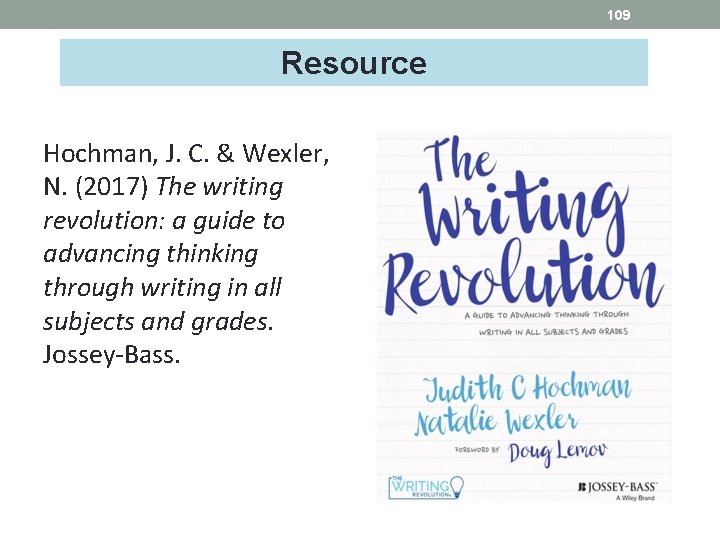
109 Resource Hochman, J. C. & Wexler, N. (2017) The writing revolution: a guide to advancing thinking through writing in all subjects and grades. Jossey-Bass.
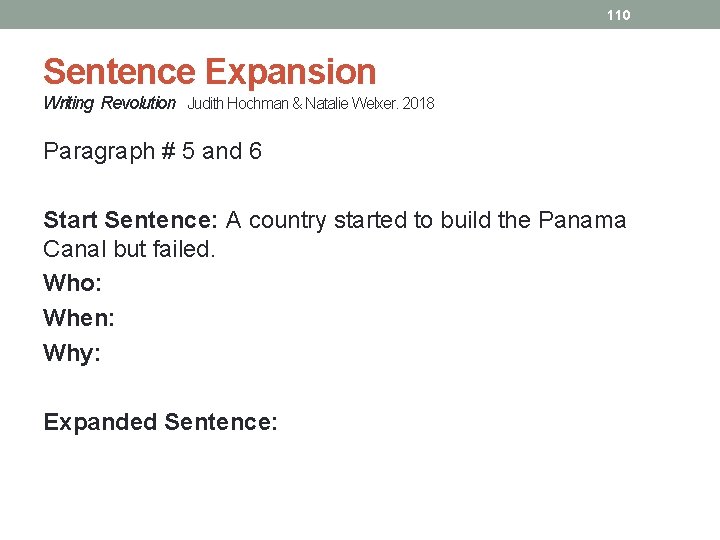
110 Sentence Expansion Writing Revolution Judith Hochman & Natalie Welxer. 2018 Paragraph # 5 and 6 Start Sentence: A country started to build the Panama Canal but failed. Who: When: Why: Expanded Sentence:

111 Sentence Expansion Writing Revolution Judith Hochman & Natalie Welxer. 2018 Paragraph # 5 and 6 Start Sentence: A country started to build the Panama Canal but failed. Who: France When: in 1879 Why: hot, rainy weather, tropical diseases, not enough money to finish the project Expanded Sentence: In 1879, France started to build the Panama Canal but failed because of the hot, rainy weather, tropical diseases. and not enough money to finish the project.
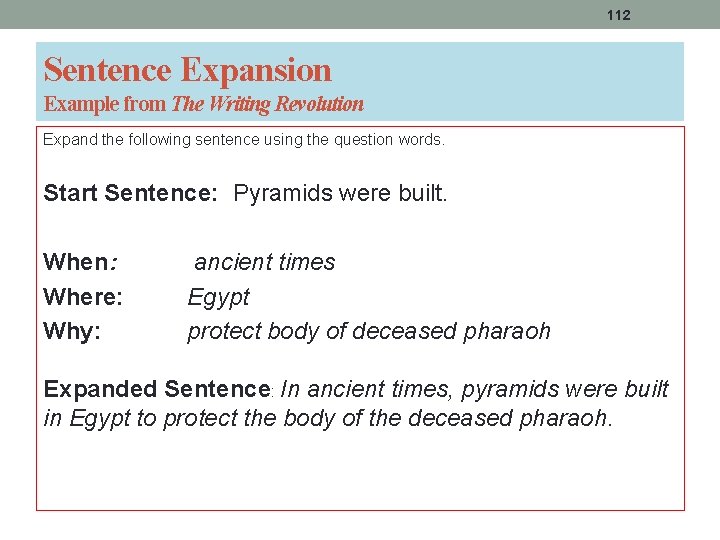
112 Sentence Expansion Example from The Writing Revolution Expand the following sentence using the question words. Start Sentence: Pyramids were built. When: Where: Why: ancient times Egypt protect body of deceased pharaoh Expanded Sentence: In ancient times, pyramids were built in Egypt to protect the body of the deceased pharaoh.
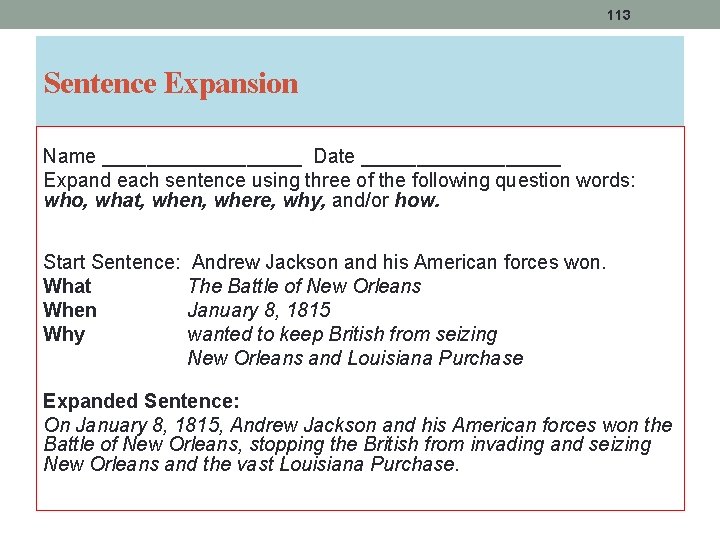
113 Sentence Expansion Name _________ Date _________ Expand each sentence using three of the following question words: who, what, when, where, why, and/or how. Start Sentence: What When Why Andrew Jackson and his American forces won. The Battle of New Orleans January 8, 1815 wanted to keep British from seizing New Orleans and Louisiana Purchase Expanded Sentence: On January 8, 1815, Andrew Jackson and his American forces won the Battle of New Orleans, stopping the British from invading and seizing New Orleans and the vast Louisiana Purchase.
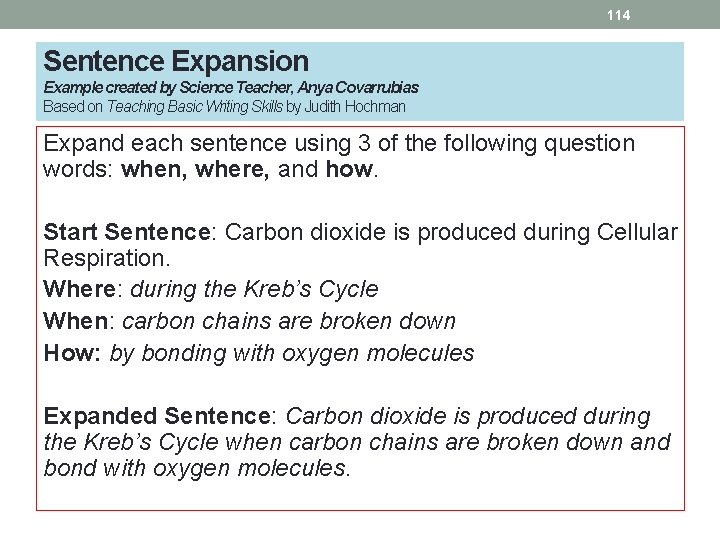
114 Sentence Expansion Example created by Science Teacher, Anya Covarrubias Based on Teaching Basic Writing Skills by Judith Hochman Expand each sentence using 3 of the following question words: when, where, and how. Start Sentence: Carbon dioxide is produced during Cellular Respiration. Where: during the Kreb’s Cycle When: carbon chains are broken down How: by bonding with oxygen molecules Expanded Sentence: Carbon dioxide is produced during the Kreb’s Cycle when carbon chains are broken down and bond with oxygen molecules.

115 Because But So Writing Revolution Judith Hochman & Natalie Welxer. 2018 The Panama Canal is an amazing phenomenon because. . . The Panama Canal is an amazing phenomenon, but. . . The Panama Canal is an amazing phenomenon, so. . .

116 Because But So Writing Revolution Judith Hochman & Natalie Welxer. 2018 The Panama Canal is an amazing phenomenon because it allows ships to quickly sail from the Atlantic Ocean to the Pacific Ocean. It is also amazing because of the sophistication of the engineering though it was build from 1904 to 1913. The Panama Canal is an amazing phenomenon, but its construction cost thousands of workers their lives. The Panama Canal is an amazing phenomenon, so it continues to be improved, transporting more and more ships from the Atlantic to the Pacific for the purposes of trade and tourism.
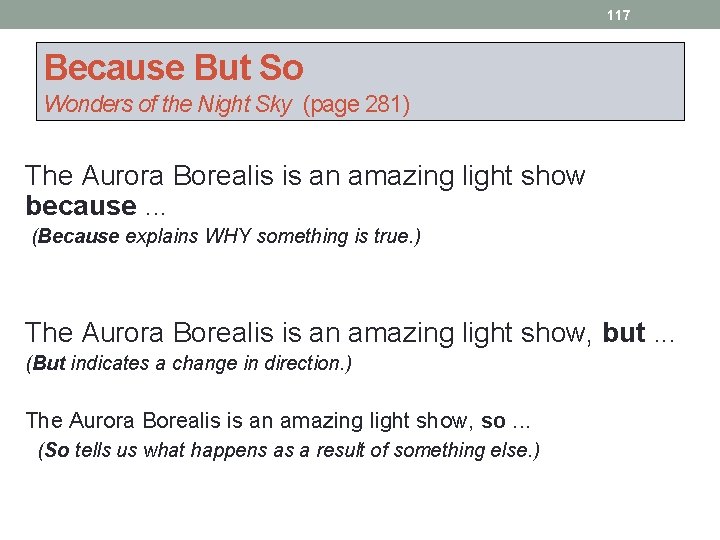
117 Because But So Wonders of the Night Sky (page 281) The Aurora Borealis is an amazing light show because. . . (Because explains WHY something is true. ) The Aurora Borealis is an amazing light show, but. . . (But indicates a change in direction. ) The Aurora Borealis is an amazing light show, so. . . (So tells us what happens as a result of something else. )

118 Because But So Wonders of the Night Sky (page 281) Possible Answers The Aurora Borealis is an amazing light show because electrical charges cause colorful bands of light. (Because explains WHY something is true. ) The Aurora Borealis is an amazing light show, but it only occurs every few years. (But indicates a change in direction. ) The Aurora Borealis is an amazing light show, so we should travel to the North Pole to observe “the northern lights. ” (So tells us what happens as a result of something else. )
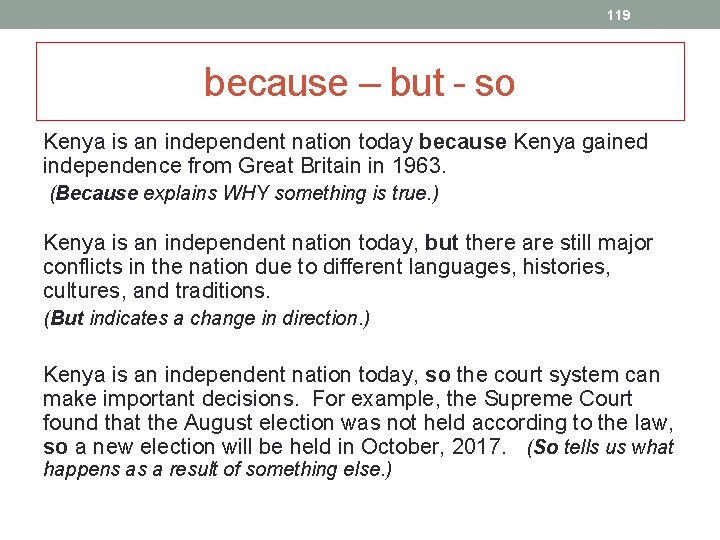
119 because – but - so Kenya is an independent nation today because Kenya gained independence from Great Britain in 1963. (Because explains WHY something is true. ) Kenya is an independent nation today, but there are still major conflicts in the nation due to different languages, histories, cultures, and traditions. (But indicates a change in direction. ) Kenya is an independent nation today, so the court system can make important decisions. For example, the Supreme Court found that the August election was not held according to the law, so a new election will be held in October, 2017. (So tells us what happens as a result of something else. )

120 AFTER READING Summary – Strategy
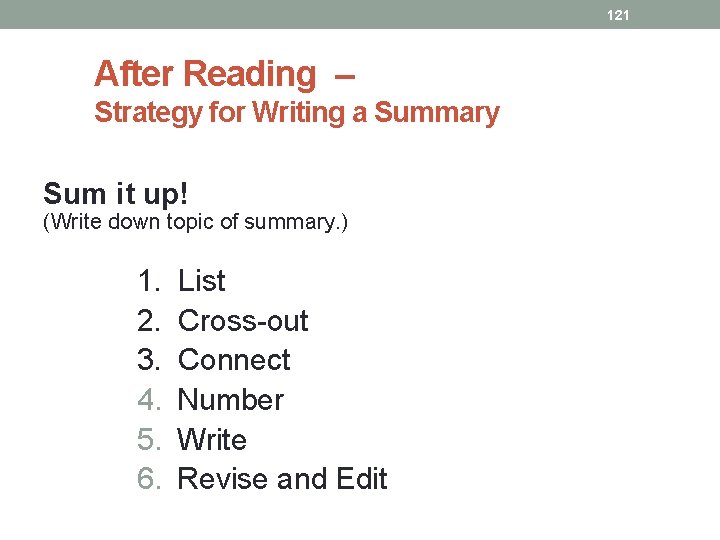
121 After Reading – Strategy for Writing a Summary Sum it up! (Write down topic of summary. ) 1. 2. 3. 4. 5. 6. List Cross-out Connect Number Write Revise and Edit
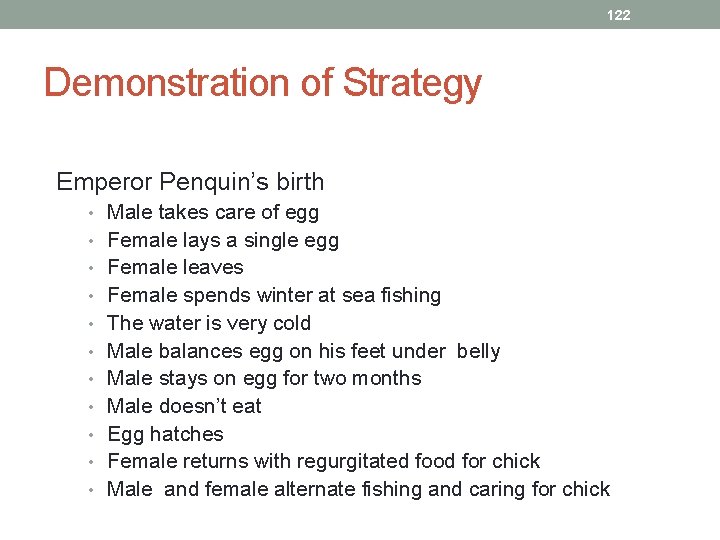
122 Demonstration of Strategy Emperor Penquin’s birth • Male takes care of egg • Female lays a single egg • Female leaves • Female spends winter at sea fishing • The water is very cold • Male balances egg on his feet under belly • Male stays on egg for two months • Male doesn’t eat • Egg hatches • Female returns with regurgitated food for chick • Male and female alternate fishing and caring for chick
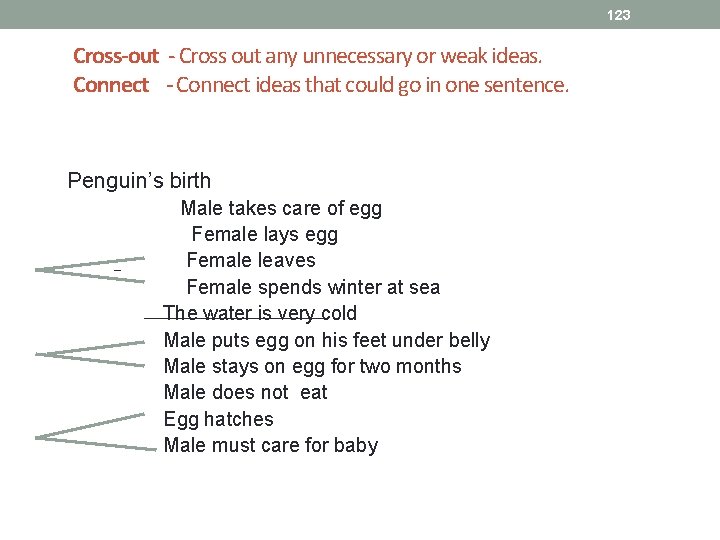
123 Cross-out - Cross out any unnecessary or weak ideas. Connect - Connect ideas that could go in one sentence. Penguin’s birth Male takes care of egg Female lays egg Female leaves Female spends winter at sea The water is very cold Male puts egg on his feet under belly Male stays on egg for two months Male does not eat Egg hatches Male must care for baby
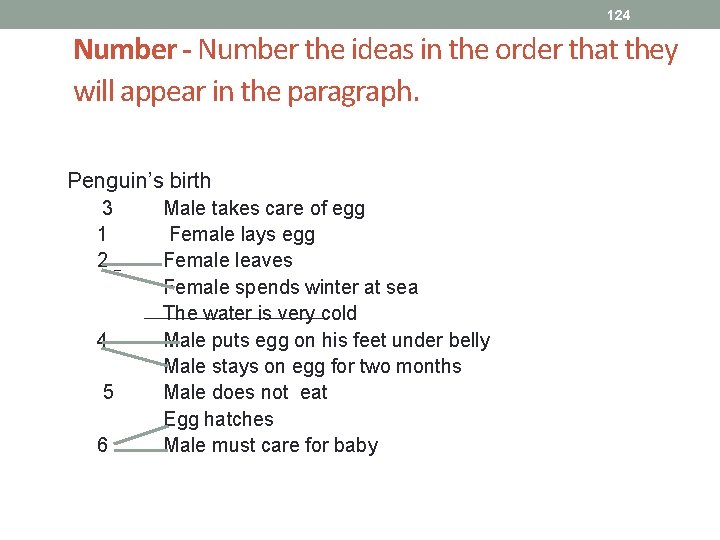
124 Number - Number the ideas in the order that they will appear in the paragraph. Penguin’s birth 3 1 2 4 5 6 Male takes care of egg Female lays egg Female leaves Female spends winter at sea The water is very cold Male puts egg on his feet under belly Male stays on egg for two months Male does not eat Egg hatches Male must care for baby

125 Write a summary. The birth process of penguins is different from that of other animals. The female penguin lays an egg. Soon after laying the egg, the female penguin leaves and spends the winter in the sea. Meanwhile the male must take care of the egg. For two months, he places the egg on his feet under his belly. During this time, the male penguin does not eat. Even after the baby penguin hatches, the male penguin continues to take care of the infant penguin.

126 AFTER READING Summary – Writing Frames
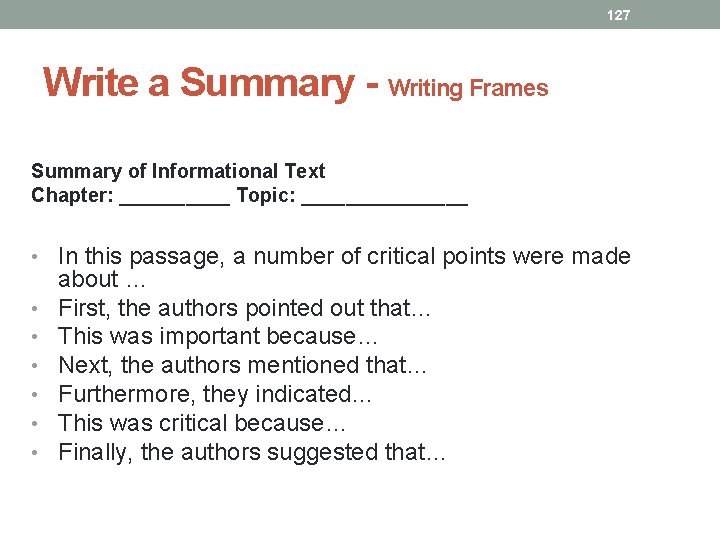
127 Write a Summary - Writing Frames Summary of Informational Text Chapter: _____ Topic: ________ • In this passage, a number of critical points were made • • • about … First, the authors pointed out that… This was important because… Next, the authors mentioned that… Furthermore, they indicated… This was critical because… Finally, the authors suggested that…
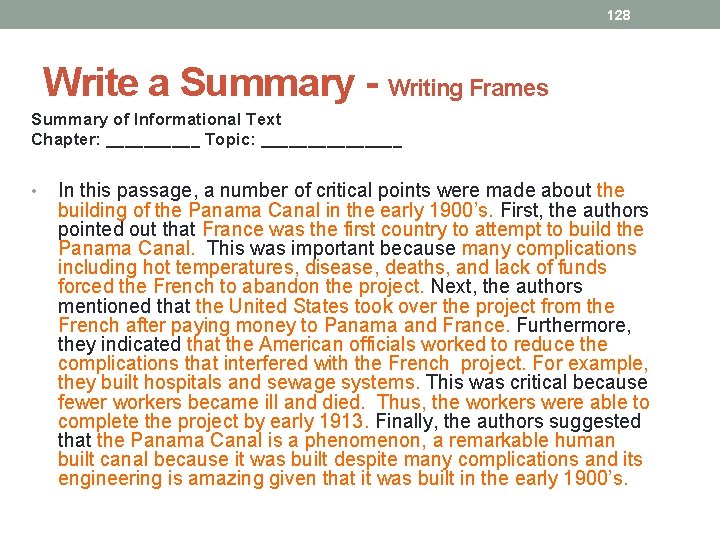
128 Write a Summary - Writing Frames Summary of Informational Text Chapter: _____ Topic: ________ • In this passage, a number of critical points were made about the building of the Panama Canal in the early 1900’s. First, the authors pointed out that France was the first country to attempt to build the Panama Canal. This was important because many complications including hot temperatures, disease, deaths, and lack of funds forced the French to abandon the project. Next, the authors mentioned that the United States took over the project from the French after paying money to Panama and France. Furthermore, they indicated that the American officials worked to reduce the complications that interfered with the French project. For example, they built hospitals and sewage systems. This was critical because fewer workers became ill and died. Thus, the workers were able to complete the project by early 1913. Finally, the authors suggested that the Panama Canal is a phenomenon, a remarkable human built canal because it was built despite many complications and its engineering is amazing given that it was built in the early 1900’s.

129 Summary – Narrative Frame The title of this story was …… The setting of the story was …. . …… was the main character of the story. In the story, we learned that …. was …. . His/her main problem/conflict/goal was … At first, … tried to resolve this problem/conflict/goal by … Later, he/she tried to resolve the problem/conflict/goal by… In the end, the following happened: …

130 Summary – Narrative Example The title of this story was My Summer Vacation. The setting of the story was a cattle ranch in Texas during summer vacation. Wallace was the main character of the story. We learned that Wallace was a young city boy who was spending his summer with the crew on the ranch. His main problem was that he had to learn all of the skills of a wrangler such as how to move the cattle from one location to another and use a lasso properly. At first, Wallace tried to resolve this problem by carefully observing the ranch hands and mimicking their behaviors. Later, he tried to resolve the problem by asking the other wranglers, the ranch manager, and even the cook to teach him ranch skills. In the end, the following happened: Wallace stopped a stampede.

131 Summary - Video Although I already knew that. . . I learned some new facts from the video titled. . . I learned. . . I also discovered that. . . Another fact I learned was. . . However, the most important/interesting thing I became aware of was. . .

132 Summary - Video Although I already knew that migrating Vaux Swifts gather in NW Portland, Oregon in the fall, I learned some new facts from the video titled Vaux Swifts. I learned that the Vaux Swifts can not perch like other song birds due to the structure of their claws. These birds either cling to the walls of a hollow tree or a chimney or fly. I also discovered that their natural habitat is declining, forcing them to sleep in chimneys. Another fact I learned was that up to 30, 000 swifts gather at Chapman Elementary School where they dive down into the chimney at sunset. However, the most interesting thing I became aware of was that the children at the school are very supportive of the migrating Vaux Swifts. To protect the swifts in the school chimney, the heat is turned off until the swifts migrate, resulting in the students wearing sweaters and coats in class.

133 After Reading - Review • Discuss content in response to well-designed question/task • Summarize Passage Content – Written • Sentence Summary • Paragraph Summary – Strategy • Paragraph Summary – Writing Frame
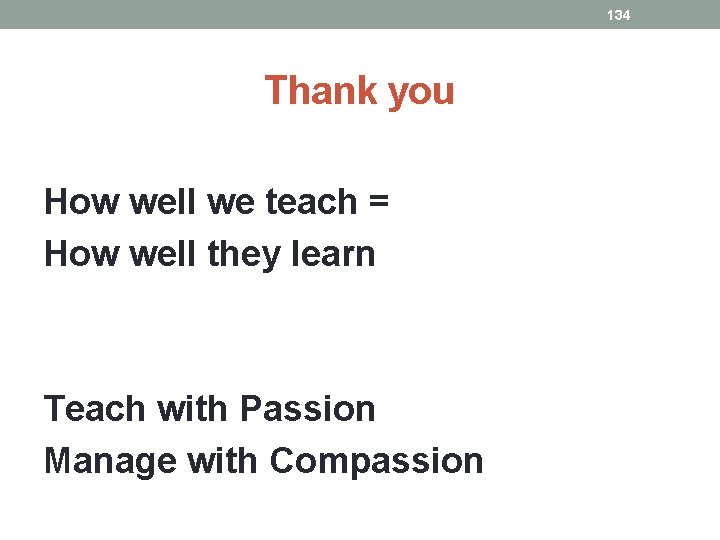
134 Thank you How well we teach = How well they learn Teach with Passion Manage with Compassion
- Slides: 134